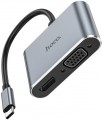USB А
The number of USB inputs located on the case of the card reader or hub (see "Type"). The number of USB ports that you will have at your disposal after connecting the device depends on this parameter. "Pure" card readers and combined models, usually, have 1,
2 and even
3 USB inputs, while hubs have
4 or more ports.
USB A version
This paragraph refers to the USB connector interface. The main difference between the interface versions is speed. It is worth noting that the speed of the input connector does not yet indicate the overall throughput, since the simultaneous connection of
flash drives,
phones, memory cards slows down data transfer, which anyway is limited by the interface for connecting the device itself to a PC or
laptop(item "Connection interface").
- USB 2.0. The outdated version 2.0 provides data transfer rates up to 480 Mbps. Found only in USB A ports.
- USB 3.2 gen1. The previous names of the USB 3.1 gen1 and USB 3.0 standard (they know how to confuse). This version provides 10 times the maximum speed (4.8Gbps) as well as higher power supply, which allows you to connect power-hungry devices and large splitters.
- USB 3.2 gen2. Further improvement of the USB 3.2 gen1 standard (and, as is customary, the previous name USB 3.1 gen1 and simply USB 3.1, which was renamed more than once), made it possible to achieve a maximum speed of 10 Gbps and even higher power for external devices.
USB type C
The number of USB Type C ports for connecting peripherals provided in the design of the hub (or card reader with the hub function — see "Type").
The port itself is small — only slightly larger than microUSB — and has a reversible design, thanks to which the plug can be inserted in either direction. That is why he has exacted respect and is actively replacing the classic USB port.
Despite its small size, USB Type C is used both in portable technology and in desktop PCs and peripherals for them. However, there are still few such devices available; because of this, hubs usually provide
1 USB-C port or
2 type C inputs.
USB-C version
The USB connector interface (version) primarily characterizes the speed.
- 2.0. The outdated version 2.0 provides data transfer rates up to 480 Mbps. Found only in USB A ports.
— 3.2 gen1. Previous standard names are 3.1 gen1 and 3.0. This version provides up to 10 times the maximum speed (4.8Gbps) as well as higher power capacity, which allows you to connect power-hungry devices and large splitters.
- 3.2 gen2. Further improvement of the 3.2 gen1 standard (and, as is customary, the previous name more than once renamed 3.1 gen1 and simply 3.1), which made it possible to achieve a maximum speed of 10 Gbps and even higher power for external devices.
However, the final speed depends not so much on the input connector, but on the USB version of the hub (card reader) connection to the PC.

